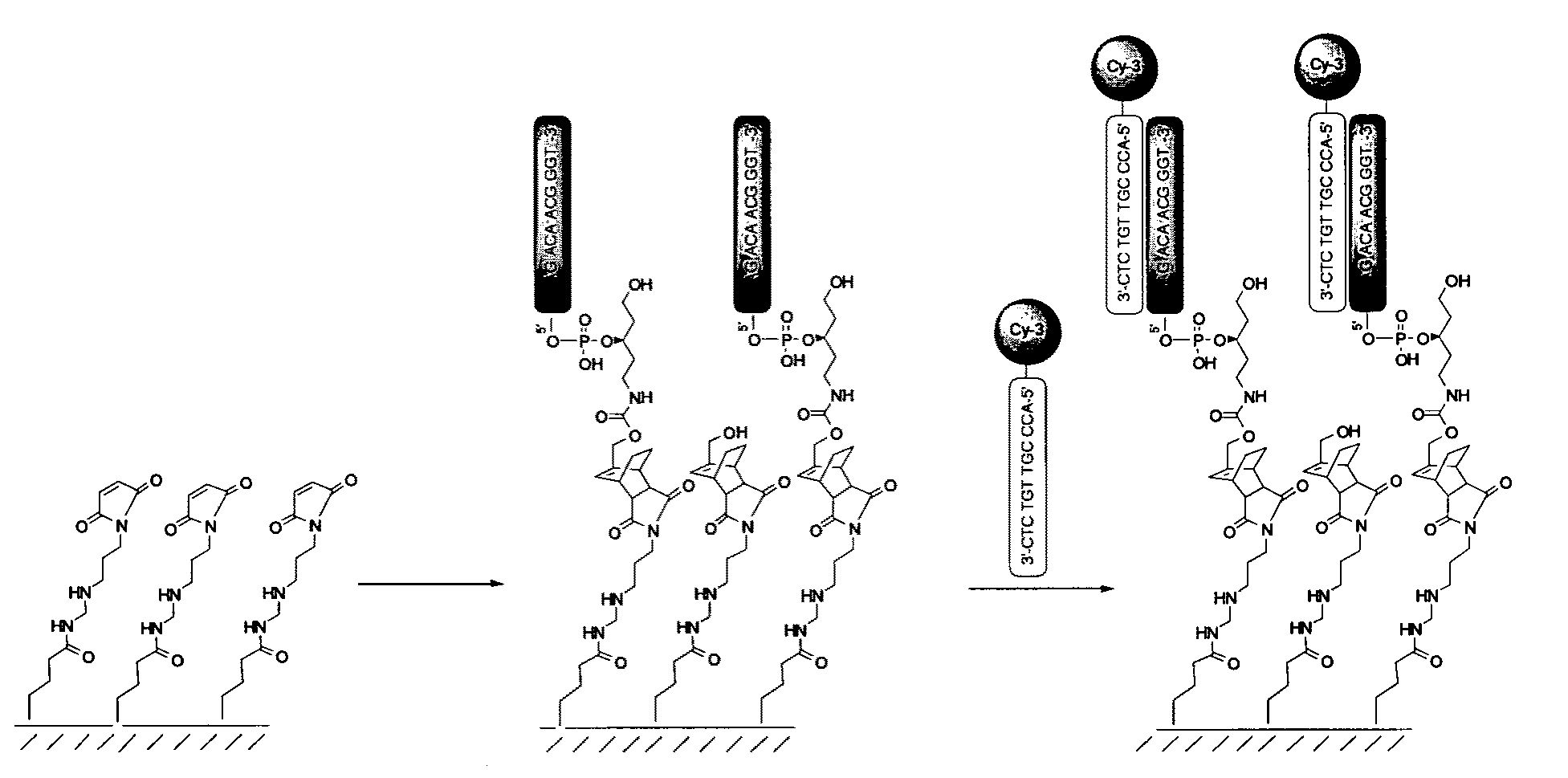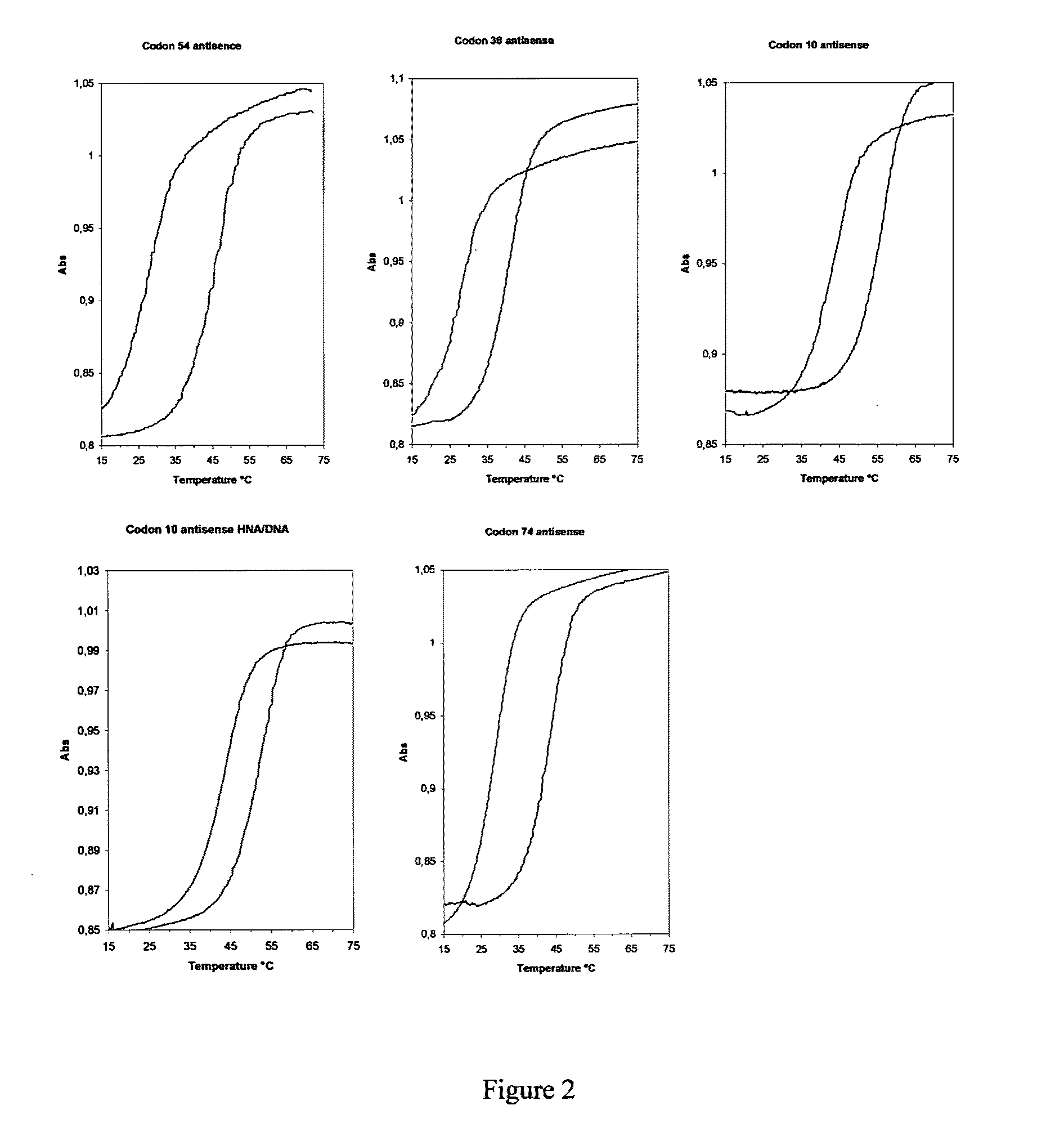Oligonucleotide arrays
- Summary
- Abstract
- Description
- Claims
- Application Information
AI Technical Summary
Benefits of technology
Problems solved by technology
Method used
Image
Examples
example 1
Materials and Methods For the Production of Arrays and Detection of Match / Mismatch Sequences With Oligonucleotides Comprising Six-Membered Sugar Ring Nucleosides
[0127]Materials
[0128]Chemicals were of analytical grade and used as received from commercial sources, unless indicated. Reagents for DNA / RNA synthesizer were purchased from Applied Biosystems (Tokyo, Japan) and Glen Research Co. (Sterling, Va., USA). Cyclohexadiene linker (R)—O-cyclohexa-2,4-dienylmethyl-N-{3-[(2-cyanoethoxy)diisopropylaminophosphano]-5-(4-methoxytrityl)}-3-hydroxypentylcarbamate was prepared follow by a known procedure starting from 5-hydroxymethylcyclohexa-1,3-diene (Hill, K. W. et al. J. Org. Chem., 2001, 66, 5352-5358). The 5′-Cy3 and 5′-Cy5 labeled oligoribonucleotides were purchased from Integrated DNA Technologies, Inc (Coralville, Iowa, USA). Glass substrates, hybridization and washing buffers (SMM, UHS, WB1, WB2, and WB3) were purchased from TeleChem International, Inc. (Sunnyvale, Calif., USA).
[...
example 2
Detection of Match / Mismatch Sequences For Mutant HIV Strains With ANA and / or HNA Comprising Oligonucleotide Arrays
[0139]For testing the selectivity and sensitivity of the HNA / ANA arrays (and compare their properties with regular DNA arrays), we selected sequences in the reverse transcriptase gene and the protease gene of HIV-1 where the wild-type and the mutant types of the virus are distinguished by one or two point mutations, which give rise to the generation of drug resistant strains. The selected point mutations are examples of Pu→Pu, Py→Py and Py→Pu interconversions. The Cy-5 and Cy-3 fluorescent dyes were chosen for the labeling of oligonucleotides to monitor the arraying and hybridization of HNA / ANA and DNA oligonucleotides because of these dyes being stable in standard conditions of oligonucleotide synthesis and deprotection, and they can be detected with commercially available microarray scanners.
[0140]Although hybridization conditions are different in solution and on sol...
example 3
Controllable Loading of Maleimido-Functionalized Glass Slides For Oligonucleotide Arraying Using Diels-Alder Cycloaddition Reaction and Hybridization
[0148]Slides, Spotting and Hybridization Conditions
[0149]Amino coated glass substrates were functionalized with covalently linked maleimide using maleimidopropionic acid NHS-ester as described in Kusnezow, W. et al. Proteomics 2003, 3, 254-264.
[0150]Spotting and Immobilization Procedure.
[0151]Diene-functionalized oligonucleotides were dissolved in 0.1 M NaH2PO4 (pH 6.5) at 5 pmol / ul concentration and spotted with a 40 ul Pipetteman using SecureSeal™ chambers SA8R-0.5 from Grace Bio-Labs, Inc. (Bend, Oreg., USA). Each slide was once spotted with Cy3-labeled diene-functionalized oligonucleotide to monitor loading of arrays and once with mixture of Cy3 and Cy5-labeled non-functionalized oligonucleotides to monitor non-specific binding of oligonucleotides and to calculate the background for subtraction from average intensity within array...
PUM
| Property | Measurement | Unit |
|---|---|---|
| Temperature | aaaaa | aaaaa |
| Temperature | aaaaa | aaaaa |
| Temperature | aaaaa | aaaaa |
Abstract
Description
Claims
Application Information
 Login to view more
Login to view more - R&D Engineer
- R&D Manager
- IP Professional
- Industry Leading Data Capabilities
- Powerful AI technology
- Patent DNA Extraction
Browse by: Latest US Patents, China's latest patents, Technical Efficacy Thesaurus, Application Domain, Technology Topic.
© 2024 PatSnap. All rights reserved.Legal|Privacy policy|Modern Slavery Act Transparency Statement|Sitemap



